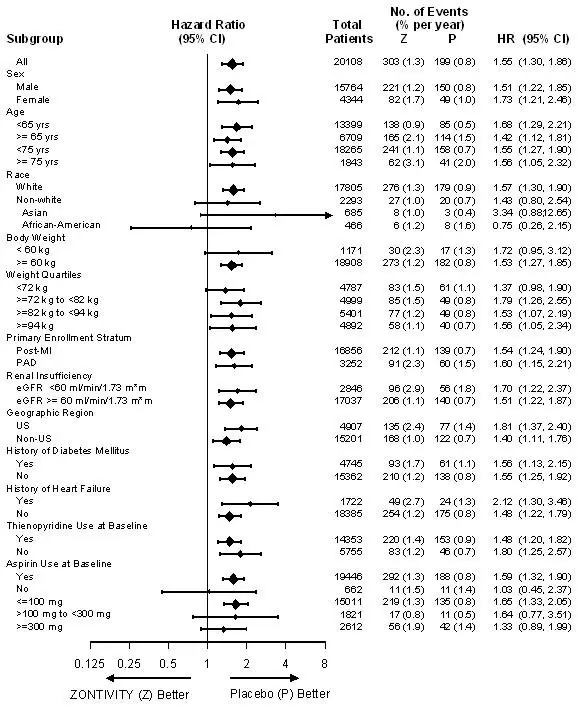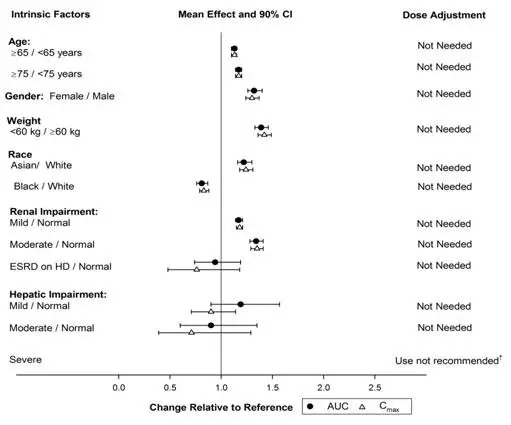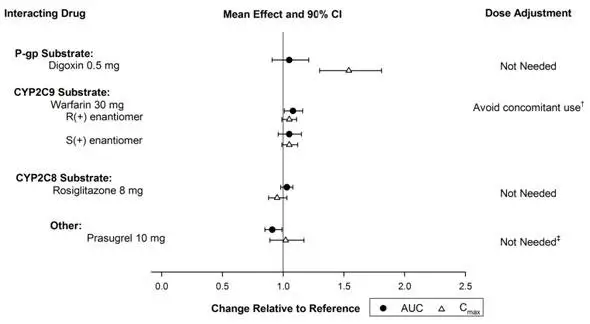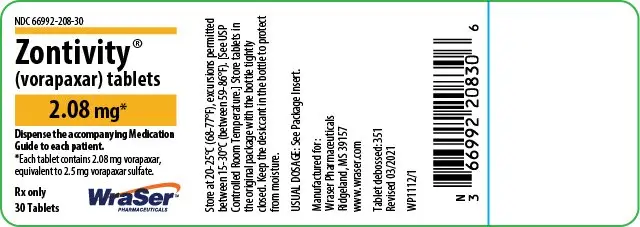Drug Detail:Zontivity (Vorapaxar [ vor-a-pax-ar ])
Drug Class: Protease-activated receptor-1 antagonists
Highlights of Prescribing Information
ZONTIVITY ® (vorapaxar) Tablets 2.08 mg*, for oral use
*Equivalent to 2.5 mg vorapaxar sulfate
Initial U.S. Approval: 2014
WARNING: BLEEDING RISK
See full prescribing information for complete boxed warning.
- Do not use ZONTIVITY in patients with a history of stroke, transient ischemic attack (TIA), or intracranial hemorrhage (ICH); or active pathological bleeding. ( 4.1, 4.2)
- Antiplatelet agents, including ZONTIVITY, increase the risk of bleeding, including ICH and fatal bleeding. ( 5.1)
Indications and Usage for Zontivity
ZONTIVITY is a protease-activated receptor-1 (PAR-1) antagonist indicated for the reduction of thrombotic cardiovascular events in patients with a history of myocardial infarction (MI) or with peripheral arterial disease (PAD). ZONTIVITY has been shown to reduce the rate of a combined endpoint of cardiovascular death, MI, stroke, and urgent coronary revascularization. ( 1.1)
Zontivity Dosage and Administration
- One tablet of ZONTIVITY orally once daily. ( 2.1)
- Use with aspirin and/or clopidogrel according to their indications or standard of care. There is limited clinical experience with other antiplatelet drugs and none with ZONTIVITY as the only antiplatelet agent. ( 2.2)
Dosage Forms and Strengths
Tablets: 2.08 mg vorapaxar. ( 3)
Contraindications
- History of stroke, TIA, or ICH. ( 4.1)
- Active pathologic bleeding. ( 4.2)
Warnings and Precautions
- Like other antiplatelet agents, ZONTIVITY increases the risk of bleeding. ( 5.1)
- Avoid use with strong CYP3A inhibitors or inducers. ( 5.2)
Adverse Reactions/Side Effects
- Bleeding, including life-threatening and fatal bleeding, is the most commonly reported adverse reaction. ( 6.1)
To report SUSPECTED ADVERSE REACTIONS, contact WraSer Pharmaceuticals at 1-800-988-6115 or FDA at 1-800-FDA-1088 or www.fda.gov/medwatch.
Use In Specific Populations
- Pregnancy: When pregnancy is detected, discontinue vorapaxar and initiate appropriate alternative therapy. ( 8.1)
- Lactation: Breastfeeding not recommended. ( 8.2)
See 17 for PATIENT COUNSELING INFORMATION and Medication Guide.
Revised: 10/2022
Full Prescribing Information
WARNING: BLEEDING RISK
- Do not use ZONTIVITY in patients with a history of stroke, transient ischemic attack (TIA), or intracranial hemorrhage (ICH); or active pathological bleeding [see CONTRAINDICATIONS (4.1, 4.2)] .
- Antiplatelet agents, including ZONTIVITY, increase the risk of bleeding, including ICH and fatal bleeding [see Warnings and Precautions (5.1)].
1. Indications and Usage for Zontivity
1.1 Patients with History of Myocardial Infarction (MI) or with Peripheral Arterial Disease (PAD)
ZONTIVITY ® is indicated for the reduction of thrombotic cardiovascular events in patients with a history of myocardial infarction (MI) or with peripheral arterial disease (PAD). ZONTIVITY has been shown to reduce the rate of a combined endpoint of cardiovascular death, MI, stroke, and urgent coronary revascularization (UCR).
2. Zontivity Dosage and Administration
2.1 General Dosing Information
Take one tablet of ZONTIVITY 2.08 mg orally once daily, with or without food.
2.2 Coadministration with Other Antiplatelet Drugs
There is no experience with use of ZONTIVITY alone as the only administered antiplatelet agent. ZONTIVITY has been studied only as an addition to aspirin and/or clopidogrel. Use ZONTIVITY with aspirin and/or clopidogrel according to their indications or standard of care [see Clinical Studies (14)] . There is limited clinical experience with other antiplatelet drugs.
3. Dosage Forms and Strengths
ZONTIVITY tablets, 2.08 mg vorapaxar, are yellow, oval-shaped, film-coated tablets with "351" on one side.
4. Contraindications
4.1 History of Stroke, Transient Ischemic Attack (TIA), or Intracranial Hemorrhage (ICH)
ZONTIVITY is contraindicated in patients with a history of stroke, TIA, or ICH because of an increased risk of ICH in this population [see Adverse Reactions (6)] .
Discontinue ZONTIVITY in patients who experience a stroke, TIA, or ICH [see Adverse Reactions (6.1) and Clinical Studies (14)] .
5. Warnings and Precautions
5.1 General Risk of Bleeding
Antiplatelet agents, including ZONTIVITY, increase the risk of bleeding, including ICH and fatal bleeding [see Adverse Reactions (6.1)] .
ZONTIVITY increases the risk of bleeding in proportion to the patient's underlying bleeding risk. Consider the underlying risk of bleeding before initiating ZONTIVITY. General risk factors for bleeding include older age, low body weight, reduced renal or hepatic function, history of bleeding disorders, and use of certain concomitant medications (e.g., anticoagulants, fibrinolytic therapy, chronic nonsteroidal anti-inflammatory drugs [NSAIDS], selective serotonin reuptake inhibitors, serotonin norepinephrine reuptake inhibitors) increases the risk of bleeding [see Use in Specific Populations (8.7) and Clinical Pharmacology (12.3)] . Avoid concomitant use of warfarin or other anticoagulants.
Suspect bleeding in any patient who is hypotensive and has recently undergone coronary angiography, percutaneous coronary intervention (PCI), coronary artery bypass graft surgery (CABG), or other surgical procedures.
Withholding ZONTIVITY for a brief period will not be useful in managing an acute bleeding event because of its long half-life. There is no known treatment to reverse the antiplatelet effect of ZONTIVITY. Significant inhibition of platelet aggregation remains 4 weeks after discontinuation [see Overdosage (10) and Clinical Pharmacology (12.2, 12.3)].
6. Adverse Reactions/Side Effects
The following serious adverse reaction is also discussed elsewhere in the labeling:
- Bleeding [see Boxed Warning and Warnings and Precautions (5.1)] .
6.1 Clinical Trials Experience
Because clinical trials are conducted under widely varying conditions, adverse reaction rates observed in the clinical trials of a drug cannot be directly compared to rates in the clinical trials of another drug and may not reflect the rates observed in clinical practice.
ZONTIVITY was evaluated for safety in 13,186 patients, including 2,187 patients treated for more than 3 years, in the Phase 3 study TRA 2°P TIMI 50 (Thrombin Receptor Antagonist in Secondary Prevention of Atherothrombotic Ischemic Events). The overall study population, patients who had evidence or a history of atherosclerosis involving the coronary (post-MI), cerebral (ischemic stroke), or peripheral vascular (documented history of PAD) systems, was treated once a day with ZONTIVITY (n=13,186) or placebo (n=13,166). Patients randomized to ZONTIVITY received treatment for a median of 2.3 years.
The adverse events in the ZONTIVITY-treated (n=10,059) and placebo-treated (n=10,049) post-MI or PAD patients with no history of stroke or TIA are shown below [see Contraindications (4)] .
Bleeding
GUSTO severe bleeding was defined as fatal, intracranial, or bleeding with hemodynamic compromise requiring intervention; GUSTO moderate bleeding was defined as bleeding requiring transfusion of whole blood or packed red blood cells without hemodynamic compromise. (GUSTO: Global Utilization of Streptokinase and Tissue Plasminogen Activator for Occluded Arteries.)
The results for the bleeding endpoints in the post-MI or PAD patients without a history of stroke or TIA are shown in Table 1. ZONTIVITY increased GUSTO moderate or severe bleeding by 55%.
| Placebo
(n=10,049) | ZONTIVITY
(n=10,059) | ||||
| Endpoints | Patients with events
(%) | K-M % * | Patients with events
(%) | K-M % * | Hazard Ratio
†,‡
(95% CI) |
|
|||||
| GUSTO Bleeding Categories | |||||
| Severe | 82 (0.8%) | 1.0% | 100 (1.0%) | 1.3% | 1.24 (0.92 - 1.66) |
| Moderate or Severe | 199 (2.0%) | 2.4% | 303 (3.0%) | 3.7% | 1.55 (1.30 - 1.86) |
| Any GUSTO Bleeding (Severe/Moderate/Mild) | 1769 (17.6%) | 19.8% | 2518 (25.0%) | 27.7% | 1.52 (1.43 - 1.61) |
| Fatal Bleeding | 14 (0.1%) | 0.2% | 16 (0.2%) | 0.2% | 1.15 (0.56 - 2.36) |
| Intracranial Hemorrhage (ICH) | 31 (0.3%) | 0.4% | 45 (0.4%) | 0.6% | 1.46 (0.92-2.31) |
| Clinically Significant Bleeding † | 950 (9.5%) | 10.9% | 1349 (13.4%) | 15.5% | 1.47 (1.35 - 1.60) |
| Gastrointestinal Bleeding | 297 (3.0%) | 3.5% | 400 (4.0%) | 4.7% | 1.37 (1.18-1.59) |
The effects of ZONTIVITY on bleeding were examined in a number of subsets based on demographic and other baseline characteristics. Many of these are shown in Figure 1. Such analyses must be interpreted cautiously, as differences can reflect the play of chance among a large number of analyses.
| Figure 1: Subgroup Analyses (GUSTO Moderate or Severe Bleeding) in Post-MI or PAD Patients without a History of Stroke or TIA in the TRA 2°P Study (First Dose to Last Dose + 30 Days) |
|---|
|
|
In TRA 2°P, 367 post-MI or PAD patients without a history of stroke or TIA underwent CABG surgery. Study investigators were encouraged not to discontinue treatment with study drug (i.e., ZONTIVITY or placebo) prior to surgery. Approximately 12.3% of patients discontinued ZONTIVITY more than 30 days prior to CABG. The relative risk for GUSTO moderate or severe bleeding was approximately 1.2 on ZONTIVITY vs. placebo.
Bleeding events that occurred on ZONTIVITY were treated in the same manner as for other antiplatelet agents.
7. Drug Interactions
8. Use In Specific Populations
8.2 Lactation
Risk Summary
There are no data on the presence of vorapaxar or its metabolites in human milk, the effects on the breastfed infant, or the effects on milk production. When vorapaxar was administered to lactating rats, vorapaxar was actively secreted in the milk of rats. When a drug is present in animal milk, it is likely the drug will be present in human milk. Because of the potential for serious adverse reactions in the breastfed infant, such as bleeding, advise patients that breastfeeding is not recommended during treatment with ZONTIVITY.
8.4 Pediatric Use
The safety and effectiveness of ZONTIVITY in pediatric patients have not been established.
8.5 Geriatric Use
In TRA 2°P, in post-MI or PAD patients without a history of stroke or TIA, 33% of patients were ≥65 years of age and 9% were ≥75 years of age. The relative risk of bleeding (ZONTIVITY compared with placebo) was similar across age groups. No overall differences in safety or effectiveness were observed between these patients and younger patients. ZONTIVITY increases the risk of bleeding in proportion to a patient's underlying risk. Because older patients are generally at a higher risk of bleeding, consider patient age before initiating ZONTIVITY [see Adverse Reactions (6.1)].
8.6 Renal Impairment
No dose adjustment is required in patients with renal impairment [see Clinical Pharmacology (12.3)].
8.7 Hepatic Impairment
No dose adjustment is required in patients with mild and moderate hepatic impairment. Based on the increased inherent risk of bleeding in patients with severe hepatic impairment, ZONTIVITY is not recommended in such patients [see Warnings and Precautions (5.1) and Clinical Pharmacology (12.3)].
10. Overdosage
There is no known treatment to reverse the antiplatelet effect of ZONTIVITY, and neither dialysis nor platelet transfusion can be expected to be beneficial if bleeding occurs after overdose. Inhibition of platelet aggregation can be expected for weeks after discontinuation of normal dosing [see Clinical Pharmacology (12.2)] . There is no standard test available to assess the risk of bleeding in an overdose situation.
11. Zontivity Description
ZONTIVITY contains vorapaxar sulfate, a tricyclic himbacine-derived selective inhibitor of platelet aggregation mediated by PAR-1.
The chemical name of vorapaxar sulfate is ethyl [(1R,3aR,4aR,6R,8aR,9S,9aS)-9-{(1E)-2-[5-(3-fluorophenyl)pyridin-2-yl]ethen-1-yl}-1-methyl-3-oxododecahydronaphtho[2,3-c]furan-6-yl]carbamate sulfate. The empirical formula is C 29H 33FN 2O 4∙H 2SO 4, and its molecular weight is 590.7. The structural formula is:
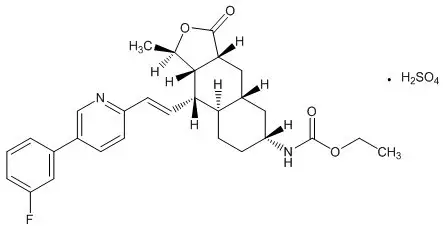
Vorapaxar sulfate is a white to off-white solid. Vorapaxar sulfate is freely soluble in methanol and slightly soluble in ethanol, acetone, 2-propanol, and acetonitrile. In aqueous solution, it is slightly soluble in pH 1; its solubility decreases with increasing pH. ZONTIVITY tablets are formulated with vorapaxar sulfate, but during manufacture and storage, partial conversion from vorapaxar sulfate to vorapaxar free base may occur.
ZONTIVITY is available for oral use as tablets containing 2.08 mg of vorapaxar, which is equivalent to 2.5 mg of vorapaxar sulfate.
Each film-coated tablet of ZONTIVITY contains the following inactive ingredients: lactose monohydrate, microcrystalline cellulose, croscarmellose sodium, povidone, and magnesium stearate. In addition, the film coating contains the following inactive ingredients: lactose monohydrate, hypromellose, titanium dioxide, triacetin (glycerol triacetate), and iron oxide yellow.
12. Zontivity - Clinical Pharmacology
12.1 Mechanism of Action
Vorapaxar is a reversible antagonist of the protease-activated receptor-1 (PAR-1) expressed on platelets, but its long half-life makes it effectively irreversible. Vorapaxar inhibits thrombin-induced and thrombin receptor agonist peptide (TRAP)-induced platelet aggregation in in vitro studies. Vorapaxar does not inhibit platelet aggregation induced by adenosine diphosphate (ADP), collagen or a thromboxane mimetic and does not affect coagulation parameters ex vivo. PAR-1 receptors are also expressed in a wide variety of cell types, including endothelial cells, neurons, and smooth muscle cells, but the pharmacodynamic effects of vorapaxar in these cell types have not been assessed.
12.2 Pharmacodynamics
At the recommended dose, ZONTIVITY achieves ≥80% inhibition of TRAP-induced platelet aggregation within one week of initiation of treatment. The duration of platelet inhibition is dose- and concentration-dependent. Inhibition of TRAP-induced platelet aggregation at a level of 50% can be expected at 4 weeks after discontinuation of daily doses of ZONTIVITY 2.08 mg, consistent with the terminal elimination half-life of vorapaxar [see Clinical Pharmacology (12.3)] .
In healthy volunteer studies, no changes in platelet P-selectin and soluble CD40 ligand (sCD40L) expression or coagulation test parameters (TT, PT, aPTT, ACT, ECT) occurred after single- or multiple- dose (28 days) administration of vorapaxar. No meaningful changes in P-selectin, sCD40L, or hs-CRP concentrations were observed in patients treated with vorapaxar in the phase 2/3 clinical trials.
12.3 Pharmacokinetics
Vorapaxar exposure increases in an approximately dose-proportional manner following single doses up to 16 times the recommended dose. Vorapaxar pharmacokinetics are similar in healthy subjects and patients.
Specific Populations
The effects of intrinsic factors on the pharmacokinetics of vorapaxar are presented in Figure 2
[see
Use in Specific Populations (8.5,
8.6,
8.7)]
.
In general, effects on the exposure of vorapaxar based on age, race, gender, weight, and moderate renal insufficiency were modest (20-40%; see Figure 2). No dose adjustments are necessary based upon these factors. Because of the inherent bleeding risks in patients with severe hepatic impairment, ZONTIVITY is not recommended in such patients [see Warnings and Precautions (5.1) and Use in Specific Populations (8.7)] .
| Figure 2: Effect of Intrinsic Factors on the Pharmacokinetics of Vorapaxar |
|---|
| † See Warnings and Precautions. (5.1) and Use in Specific Populations. (8.7) |
|
|
Effects of Other Drugs on Vorapaxar
The effects of other drugs on the pharmacokinetics of vorapaxar are presented in Figure 3 as change relative to vorapaxar administered alone (test/reference). Phase 3 data suggest that coadministration of a weak or moderate CYP3A inhibitor with vorapaxar does not increase bleeding risk or alter the efficacy of vorapaxar. No dose adjustment for ZONTIVITY is required in patients taking weak to moderate inhibitors of CYP3A.
| Figure 3: Effects of Other Drugs on the Pharmacokinetics of Vorapaxar |
|---|
| † See Warnings and Precautions. (5.2) and Drug Interactions. (7.1) |
| ‡ See Dosage and Administration. (2.2) |
|
|
Effects of Vorapaxar on Other Drugs
In vitro metabolism studies demonstrate that vorapaxar or M20 is unlikely to cause clinically significant inhibition or induction of major CYP isoforms or inhibition of OATP1B1, OATP1B3, BCRP, OAT1, OAT3, and OCT2 transporters.
Specific in vivo effects on the pharmacokinetics of digoxin, warfarin, rosiglitazone and prasugrel are presented in Figure 4 as a change relative to the interacting drug administered alone (test/reference). Vorapaxar is a weak inhibitor of the intestinal P-glycoprotein (P-gp) transporter. No dosage adjustment of digoxin or ZONTIVITY is required.
| Figure 4: Effects of Vorapaxar on the Pharmacokinetics of Other Drugs |
|---|
| † See Warnings and Precautions. (5.1) |
| ‡ See Dosage and Administration. (2.2) |
|
|
13. Nonclinical Toxicology
13.2 Animal Pharmacology
Vorapaxar did not increase bleeding time in non-human primates when administered alone. Bleeding time was prolonged slightly with administration of aspirin or aspirin plus vorapaxar. The combination of aspirin, vorapaxar, and clopidogrel produced significant prolongation of bleeding time. Transfusion of human platelet rich plasma normalized bleeding times with partial recovery of ex vivo platelet aggregation induced with arachidonic acid, but not induced with ADP or TRAP. Platelet poor plasma had no effect on bleeding times or platelet aggregation [see Warnings and Precautions (5.1)].
14. Clinical Studies
The clinical evidence for the effectiveness of ZONTIVITY is supported by TRA 2°P - TIMI 50. TRA 2°P was a multicenter, randomized, double-blind, placebo-controlled study conducted in patients who had evidence or a history of atherosclerosis involving the coronary (spontaneous MI ≥2 weeks but ≤12 months prior), cerebral (ischemic stroke), or peripheral vascular (documented peripheral arterial disease [PAD]) systems. Patients were randomized to receive daily treatment with ZONTIVITY (n=13,225) or placebo (n=13,224) in addition to standard of care. The study's primary endpoint was the composite of cardiovascular death, MI, stroke, and urgent coronary revascularization (UCR). The composite of cardiovascular death, MI, and stroke was assessed as key secondary endpoint. The median follow-up was 2.5 years (up to 4 years).
The findings in all randomized patients for the primary efficacy composite endpoint show a 3-year K-M event rate of 11.2% in the ZONTIVITY group compared to 12.4% in the placebo group (hazard ratio [HR]: 0.88; 95% confidence interval [CI], 0.82 to 0.95; p=0.001).
The findings for the key secondary efficacy endpoint show a 3-year Kaplan-Meier (K-M) event rate of 9.3% in the ZONTIVITY group compared to 10.5% in placebo group (HR 0.87; 95% CI, 0.80 to 0.94; p<0.001).
Although TRA 2°P was not designed to evaluate the relative benefits and risks of ZONTIVITY in individual patient subgroups, patients with a history of stroke or TIA showed an increased risk of ICH. Of the patients who comprised the post-MI and PAD strata and had no baseline history of stroke or TIA,10,080 were randomized to treatment with ZONTIVITY and 10,090 to placebo. These patients were 89% Caucasian, 22% female, and 33% ≥65 years of age, with a median age of 60 years. The population included patients with diabetes (24%) and patients with hypertension (65%). Of the patients who qualified for the trial with MI without a history of stroke or TIA, 98% were receiving aspirin, 78% were receiving a thienopyridine, and 77% were receiving both aspirin and a thienopyridine when they enrolled in the trial. Of the patients who qualified for the trial with PAD without a history of stroke or TIA, 88% were receiving aspirin, 35% were receiving a thienopyridine, and 27% were receiving both aspirin and a thienopyridine when they enrolled.
In post-MI or PAD patients without a history of stroke or TIA the 3-year K-M event rate for the primary efficacy endpoint (composite of time to first CV death, MI, stroke, or UCR) was 10.1% in the ZONTIVITY group compared to 11.8% in the placebo group (HR 0.83; 95% CI, 0.76 to 0.90; p<0.001) (see Figure 5 and Table 3).
The results for the key secondary efficacy endpoint (composite of time to first CV death, MI, or stroke) show a 3-year K-M event rate of 7.9% in the ZONTIVITY group compared to 9.5% in the placebo group (HR 0.80; 95% CI, 0.73 to 0.89; p<0.001) (see Table 3).
The effect of chronic dosing with ZONTIVITY on the primary and key secondary endpoints was maintained for the duration of the trial (median follow up 2.5 years, up to 4 years).
| Figure 5: Time to First Occurrence of the Composite Endpoint of CV Death, MI, Stroke or UCR in Post-MI or PAD Patients without a History of Stroke or TIA in TRA 2°P |
|---|
|
|
| Placebo
(n=10,090) | ZONTIVITY
(n=10,080) | |||||
|---|---|---|---|---|---|---|
| Endpoints | Patients with events
*
(%) | K-M % † | Patients with events
*
(%) | K-M % † | Hazard Ratio
‡,§
(95% CI) | p-value § |
|
||||||
| Primary Composite Efficacy Endpoint
(CV death/MI/stroke/UCR) *,§ | 1073 (10.6%) | 11.8% | 896 (8.9%) | 10.1% | 0.83 (0.76-0.90) | <0.001 |
| Secondary Composite Efficacy Endpoint
(CV death/MI/stroke) *,§ | 851 (8.4%) | 9.5% | 688 (6.8%) | 7.9% | 0.80 (0.73-0.89) | <0.001 |
| Other Secondary Efficacy Endpoints (first occurrences of specified event at any time) ¶ | ||||||
| CV Death | 239 (2.4%) | 2.8% | 205 (2.0%) | 2.4% | 0.86 (0.71-1.03) | |
| MI | 569 (5.6%) | 6.4% | 470 (4.7%) | 5.4% | 0.82 (0.73-0.93) | |
| Stroke | 145 (1.4%) | 1.6% | 98 (1.0%) | 1.2% | 0.67 (0.52-0.87) | |
| UCR | 283 (2.8%) | 3.0% | 249 (2.5%) | 2.8% | 0.88 (0.74-1.04) | |
In post-MI or PAD patients who survived an on-study efficacy event, the incidence of subsequent events was lower with ZONTIVITY.
The time from the prior MI to randomization had no relationship to the treatment benefit for the primary study outcome.
A range of demographic, concurrent baseline medications, and other treatment differences were examined for their influence on outcomes as shown in Figure 6. Such analyses must be interpreted cautiously, as differences can reflect the play of chance among a large number of analyses.
| Figure 6: Subgroup Analyses (Primary Endpoints) of the TRA 2°P Post-MI or PAD Patients without a History of Stroke or TIA |
|---|
|
|
16. How is Zontivity supplied
ZONTIVITY tablets, 2.08 mg vorapaxar, are yellow, oval-shaped, film-coated tablets with "351" on one side.
They are supplied as follows:
- NDC 66992-208-30 bottles of 30 tablets
- NDC 66992-208-90 bottles of 90 tablets
17. Patient Counseling Information
Advise the patient to read the FDA-approved Patient Labeling ( Medication Guide).
| Medication Guide
ZONTIVITY ® (zon-TIV-iti) (vorapaxar) Tablets |
|---|
Read this Medication Guide before you start taking ZONTIVITY and each time you get a refill. There may be new information. This information does not take the place of talking with your doctor about your medical condition or your treatment.
What is the most important information I should know about ZONTIVITY?
ZONTIVITY is used to lower your chance of having another serious problem with your heart or blood vessels, but ZONTIVITY (and similar drugs) can cause bleeding that can be serious and lead to death.
Call your doctor right away if you have any of these signs or symptoms of bleeding while taking ZONTIVITY:
- bleeding that is severe or that you cannot control
- pink, red, or brown urine
- vomiting blood or your vomit looks like "coffee grounds"
- red or black stools (looks like tar)
- coughing up blood or blood clots.
While you take ZONTIVITY and for about 4 weeks after your treatment with ZONTIVITY is stopped:
- you may bruise and bleed more easily (nose bleeds may be common)
- it will take longer than usual for any bleeding to stop.
Do not take ZONTIVITY if you:
- have had a stroke or "mini stroke" (also known as transient ischemic attack or TIA)
- have had bleeding in your brain
- currently have unusual bleeding, such as bleeding in your head, stomach or intestines (an ulcer).
If you have a stroke, TIA, or bleeding in your brain while taking ZONTIVITY your doctor should stop your treatment with ZONTIVITY. Follow your doctor's instructions about stopping ZONTIVITY.
Do not stop taking ZONTIVITY without talking to the doctor who prescribed it for you.
What is ZONTIVITY?
ZONTIVITY is a prescription medicine used to treat people who have
- had a heart attack or
- reduced blood flow in their legs (peripheral arterial disease).
ZONTIVITY is used with aspirin and/or clopidogrel to lower your chance of having another serious problem with your heart or blood vessels, such as heart attack, stroke, or death.
It is not known if ZONTIVITY is safe and effective in children.
What should I tell my doctor before taking ZONTIVITY?
Before you take ZONTIVITY, tell your doctor if you:
- have had bleeding problems or history of stomach ulcers
- have had a stroke or "mini-stroke" (also known as transient ischemic attack or TIA)
- have had any recent serious injury or surgery
- plan to have surgery or a dental procedure
- have kidney problems or severe liver problems
- are pregnant or plan to become pregnant. It is not known if ZONTIVITY will harm your unborn baby.
- are breastfeeding or plan to breastfeed. It is not known if ZONTIVITY passes into your breast milk. You and your doctor should decide if you will take ZONTIVITY or breastfeed. You should not do both.
Tell all of your doctors and dentists that you are taking ZONTIVITY. They should talk to the doctor who prescribed ZONTIVITY for you before you have any surgery or dental procedure.
Tell your doctor about all the medicines you take, including prescription and over-the-counter medicines, vitamins, dietary or herbal supplements. Taking ZONTIVITY with certain other medicines may increase your risk of bleeding and may affect how ZONTIVITY works.
Know the medicines you take. Keep a list of them to show your doctor and pharmacist when you get a new medicine.
How should I take ZONTIVITY?
Take ZONTIVITY exactly as prescribed by your doctor.
- Take ZONTIVITY 1 time each day.
- Take ZONTIVITY with or without food.
- Take ZONTIVITY with aspirin and/or clopidogrel as prescribed by your doctor.
- Do not stop taking ZONTIVITY without first talking to the doctor who prescribed it for you.
- If you take too much ZONTIVITY, call your doctor, or go to the nearest emergency room right away.
What are the possible side effects of ZONTIVITY?
- See " What is the most important information I should know about ZONTIVITY?"
- Anemia (low level of red blood cells)
- Depression
- Rash
These are not all the possible side effects of ZONTIVITY.
Call your doctor for medical advice about side effects. You may report side effects to FDA at 1-800-FDA-1088.
How should I store ZONTIVITY?
- Store ZONTIVITY at room temperature between 68°F to 77°F (20°C to 25°C).
- Keep ZONTIVITY in the bottle it comes in.
- Keep the bottle tightly closed.
- The ZONTIVITY bottle contains a desiccant packet to help keep your medicine dry (protect it from moisture). Keep the desiccant packet in the bottle. Do not throw away the desiccant packet.
- Store blister packs of ZONTIVITY in the original package it comes in.
Keep ZONTIVITY and all medicines out of the reach of children.
You can ask your doctor or pharmacist for information about ZONTIVITY that is written for health professionals.
For more information, go to www.zontivity.com or call 1-800-988-6115.
What are the ingredients in ZONTIVITY?
Active ingredient: vorapaxar sulfate
Inactive ingredients:
Tablet: lactose monohydrate, microcrystalline cellulose, croscarmellose sodium, povidone, and magnesium stearate
Film coating: lactose monohydrate, hypromellose, titanium dioxide, triacetin (glycerol triacetate), and iron oxide yellow
This Medication Guide has been approved by the U.S. Food and Drug Administration.
| ZONTIVITY
vorapaxar tablet, film coated |
||||||||||||||||||||||
|
||||||||||||||||||||||
|
||||||||||||||||||||||
|
||||||||||||||||||||||
|
||||||||||||||||||||||
|
||||||||||||||||||||||
|
||||||||||||||||||||||
| Labeler - WraSer Pharmaceuticals, LLC (121828334) |




